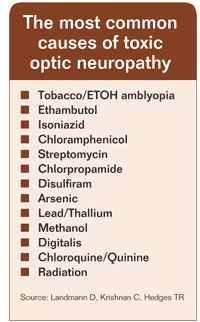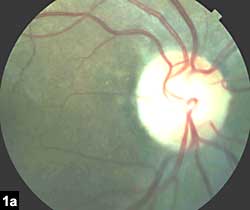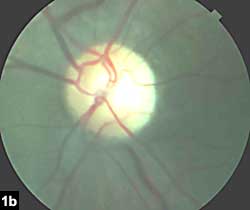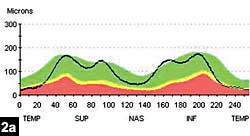Man referred for bilateral vision loss
On examination, mild temporal pallor was noted in both optic discs, and nerve fiber layer dropout was revealed in both eyes.
Click Here to Manage Email Alerts

A 76-year-old man was referred for evaluation of bilateral vision loss after failing a driver’s license vision screening test. Upon questioning, the patient noted that his vision was worse at night and that he had progressive difficulty with reading. He also noted significant glare from lights. The patient denied any headaches or pain.
History
The patient’s ocular history was significant for cataract extraction with posterior chamber IOL implantation in both eyes 1 year before presentation. His medical history included only arthritis and hay fever, and his only medication was aspirin. He had no known drug allergies. He was an African-American, born in Montserrat, an island in the West Indies, and formerly worked as an appliance repairman.
 Shazia Ahmed |  My Hanh T. Nguyen |
Examination
On initial examination, the patient’s visual acuity was 20/80 in the right eye and 20/60 in the left eye. Manifest refraction improved the vision to only 20/60 in both eyes (—1.25 right eye; –1.00 + 1.25 × 180 left eye). Pupils were equal, reactive and without afferent pupillary defect. Applanation tonometry revealed IOP of 18 mm Hg in both eyes. Anterior slit lamp exam was significant for ocular melanosis and well-placed posterior chamber IOLs in both eyes. There was no posterior capsular opacity. On gonioscopy, the ciliary band was visible 360°. Posterior segment exam was notable for mild temporal pallor of both optic discs (Figures 1a, 1b). Both fundi were otherwise unremarkable. OCT imaging revealed nerve fiber layer dropout in both eyes especially in the maculopapillary regions (Figures 2a, 2b).
The patient could read 13 out of 14 Ishihara color plates in both eyes. A central 24-2 SITA-standard visual field test revealed mild central scotomas in both eyes, although there were many fixation losses.
|
|
|
Images: Landmann D, Krishnan C, Hedges TR |

What is your diagnosis?
Bilateral vision loss
The differential diagnosis for bilateral optic nerve pallor includes optic neuropathy, optic nerve and chiasmal compressive lesions (pituitary adenoma, meningioma, gliomas, thyroid ophthalmopathy), infiltrative lesions (sarcoidosis, lymphomas, leukemias), normal tension glaucoma and prior trauma. Etiologies of optic neuropathy affecting the maculopapillary region can be divided into three classes: hereditary (autosomal dominant and Leber’s hereditary optic neuropathy), nutritional deficiency (B-complex and folic acid) and toxic (ethambutol and tobacco-alcohol amblyopia).
Our patient, who emigrated from Montserrat, most likely has a toxic optic neuropathy. In patients from the West Indies, this has been called Jamaican or tropical optic neuropathy. The sidebar lists the most common causes of toxic optic neuropathy.

Discussion and treatment
Tropical optic neuropathy is characterized by bilateral optic disc temporal pallor, bilateral reduction in visual acuity, sometimes to 20/200, and bilateral central or centrocecal scotomas. The disease is typically seen in patients originating from Jamaica, the Virgin Islands, Haiti, Barbados or Cuba as well as from Tanzania, Africa. A multitude of etiologic factors have been postulated to cause tropical optic neuropathy; however, most theories lack evidence-based support. Cassava, a plant that is a staple food in much of the tropics, is thought to induce optic neuropathy based on the high concentration of linamarin, which is enzymatically hydrolyzed to cyanide once ingested. Because cassava is rather resistant to drought, patients are more likely to ingest it at times when food resources are low (eg, after hurricanes). Another implicated etiology is bush tea, which is omnipresent in the West Indies. Bush tea can be made from up to 200 various plants and weeds.
While many forms of tropical optic neuropathy exist, they share several clinical features. Visual acuity generally remains stable over long periods of time and can even improve. Associated neurological pathologies that have been noted include nerve deafness, transient paresthesias and hemiparesis. No formal studies have been conducted, although it is generally accepted that treatment should include vitamin supplementation with B-12 and folic acid.
Our patient was advised to take a multivitamin each day. He is scheduled for an MRI to definitively rule out optic nerve compressive lesions and follow-up in 1 month.
For more information:
- Dan Landmann, MD, Chandrasekharan Krishnan, MD, and Thomas R. Hedges III, MD, can be reached at New England Eye Center, Tufts University School of Medicine, 750 Washington St., Box 450, Boston, MA 02111; 617-636-4219; fax: 617-636-4866; Web site: www.neec.com.
- Edited by Shazia Ahmed, MD, and My Hanh T. Nguyen, MD. Drs. Ahmed and Nguyen can be reached at New England Eye Center, Tufts University School of Medicine, 750 Washington St., Box 450, Boston, MA 02111; 617-636-4219; fax: 617-636-4866; Web site: www.neec.com. Drs. Ahmed and Nguyen have no direct financial interest in the products mentioned in this article, nor are they paid consultants for any companies mentioned.
References:
- Carelli V, Ross-Cisneros FN, Sadun AA. Optic nerve degeneration and mitochondrial dysfunction: genetic and acquired optic neuropathies. Neurochem Int. 2002;40(6):573-584.
- Carroll FD. Jamaican optic neuropathy in immigrants to the United States. Am J Ophthalmol. 1971;71(1 Part 2):261-265.
- Grant WM, Schuman JS. Toxicology of the Eye. 4th ed. Springfield, IL: Charles C. Thomas; 1993.
- Howell N. Leber hereditary optic neuropathy: respiratory chain dysfunction and degeneration of the optic nerve. Vision Res. 1998;38(10):1495-1504.
- Osuntokun BO, Osuntokun O. Tropical amblyopia in Nigerians. Am J Ophthalmol. 1971;72(4):708-716.
- Owen RA. Defective vision in West Indian immigrants. Br J Ophthalmol. 1966;50(10):561-569.
- Rizzo JF 3rd, Lessell S. Tobacco amblyopia. Am J Ophthalmol. 1993;116(1):84-87.
- Tuboku-Metzger AF. Degenerative tropical neuropathy and diet. Br Med J. 1969;2(5651):249-250.




